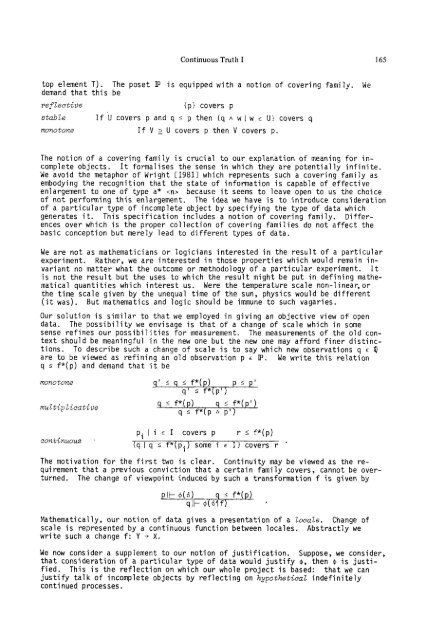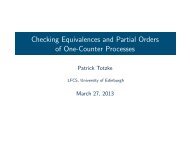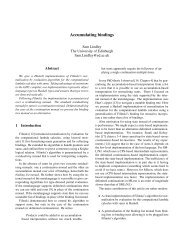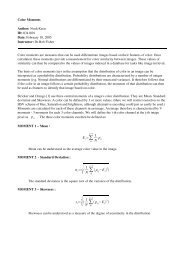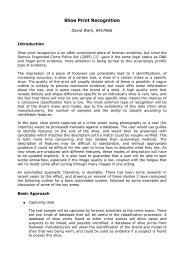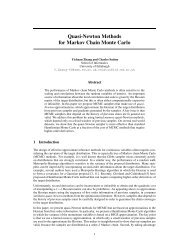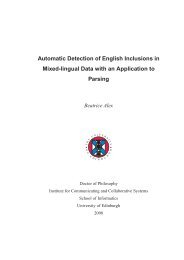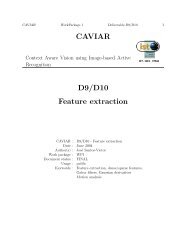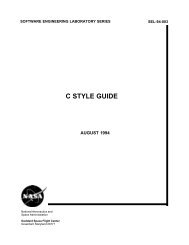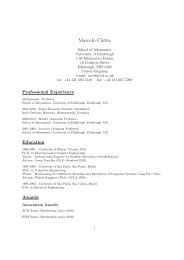Continuous Truth I Non-constructive Objects
Continuous Truth I Non-constructive Objects
Continuous Truth I Non-constructive Objects
You also want an ePaper? Increase the reach of your titles
YUMPU automatically turns print PDFs into web optimized ePapers that Google loves.
<strong>Continuous</strong> <strong>Truth</strong> I 165<br />
top element T). The poset IP is equipped with a notion of covering family. We<br />
demand that this be<br />
ref Zective<br />
stabZe<br />
ip} covers p<br />
If U covers p and q 5 p then Iq A w I w E Ul covers q<br />
monotone If V 2 U covers p then V covers p.<br />
The notion of a covering family is crucial to our explanation of meaning for incomplete<br />
objects. It formalises the sense in which they are potentially infinite.<br />
We avoid the metaphor of Wright C19811 which represents such a covering family as<br />
embodying the recognition that the state of information is capable of effective<br />
enlargement to one of type a* because it seems to leave open to us the choice<br />
of not performing this enlargement. The idea we have is to introduce consideration<br />
of a particular type of incomplete object by specifying the type of data which<br />
generates it. This specification includes a notion of covering family. Differences<br />
over which is the proper collection of covering families do not affect the<br />
basic conception but merely lead to different types of data.<br />
We are not as mathematicians or logicians interested in the result of a particular<br />
experiment. Rather, we are interested in those properties which would remain invariant<br />
no matter what the outcome or methodology of a particular experiment. It<br />
is not the result but the uses to which the result might be put in defining mathematical<br />
quantities which interest us. Were the temperature scale non-linear,or<br />
the time scale given by the unequal time of the sun, physics would be different<br />
(it was). But mathematics and logic should be immune to such vagaries.<br />
Our solution is similar to that we employed in giving an objective view of. open<br />
data. The possibility we envisage is that of a change of scale which in some<br />
sense refines our possibilities for measurement. The measurements of the old context<br />
should be meaningful in the new one but the new one may afford finer distinctions.<br />
To describe such a change of scale is to say which new observations q E Q<br />
are to be viewed as refining an old observation p E IP. We write this relation<br />
q 5 f*(p) and demand that it be<br />
monotone<br />
p 5 p'<br />
muZtip Zicative q 5 f*(p) q 5 f*(p')<br />
q 5 f*(p A p')<br />
continuous<br />
pi I i E I covers p r 5 f*(p)<br />
{q I q f*(pi) some i E 11 covers r .<br />
The motivation for the first two is clear. Continuity may be viewed as the requirement<br />
that a previous conviction that a certain family covers, cannot be overturned.<br />
The change of viewpoint induced by such a transformation f is given by<br />
Mathematically, our notion of data gives a presentation of a ZocaZe. Change of<br />
scale is represented by a continuous function between locales. Abstractly we<br />
write such a change f: Y -f X.<br />
We now consider a supplement to our notion of justification. Suppose, we consider,<br />
that consideration of a particular type of data would justify 0, then C$ is justified.<br />
This is the reflection on which our whole project is based: that we can<br />
justify talk of incomplete objects by reflecting on hypothetica2 indefinitely<br />
continued processes.


